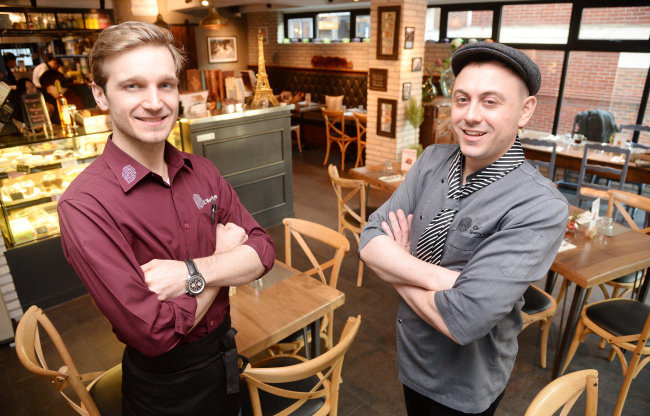Young, foreign restaurateurs make foray into Seoul alleys
More and more expats are opening their own spots away from Itaewon
By Korea HeraldPublished : Jan. 30, 2017 - 18:46

After working at a hotel kitchen and a hip Itaewon eatery for several years, French chef Gregory DeFraize, 34, decided to open a place of his own early last year.
L’Empreinte, meaning “impression,” his bistro is a 110-square meter-piece of Lyon, the chef’s hometown, in a corner of Yeonnam-dong, Seoul. The menu consists of homey French pastries, appetizers, main dishes and wine, ranging from 5,000 won ($4.3) to 30,000 won. “I didn’t want it to be too fancy,” said DeFraize.
Co-owner Kevin Scheid, 27, who also hails from Lyon and specializes in antique furniture, arranged most of the interior -- complete with a 200-year-old fireplace shipped from Europe, walnut wood tables and stone floors.
Having moved to Korea in 2007, Scheid worked as an antique dealer in Itaewon before embarking on the new venture with DeFraize.

“I wanted to make it feel like you’ve opened the door to France,” said the chef, who arrived in Seoul in 2001 with his Korean wife, also a co-owner of the restaurant.
A growing number of expat restaurateurs in their 20s and 30s are bringing the flavors of their home countries to the affordable back alleys of trendy Seoul neighborhoods, away from Itaewon, the traditional foreigner enclave.
“It depends on the landlord, but renting a space in the alleys costs about half the price of renting somewhere on the main street,” said Yeonnam-dong real estate agent Lee Jeong-hee. “Even a very small shop averages around 2.5 million won ($2,144) in the main streets of Sinchon and Hongdae.”
As young restaurant-goers today are more than willing to walk 10 minutes or so from the subway station to seek out unique restaurants, businesses thrive even on backstreets, she said.
Hongdae is now home to Italian, Russian and Spanish joints run by foreign owners; Pakistani Assad Ali operates Indo Yasijang, an Indian and Pakistani eatery in Gangnam; and Otsal near Seoul National University is owned by an Indian national.
These are people who are in Korea to stay rather than leave after teaching English or studying for a few years. Reasons for opening their own businesses are diverse. Some are wary of the typically hierarchical Korean office culture, while others see a moneymaking potential in Seoul’s increasingly diverse food scene.
DeFraize was drawn to the freedom of helming his own vision after experiencing a sense of limited growth and unstable annual contracts at Korean workplaces, he said.
“I felt there was a ceiling. It sometimes seems like a foreigner will never become a manager. You rise to a certain level, but a Korean will always be above you.”
Opening L’Empreinte was the right choice, he says, and the process smoother than expected. “Business is growing. We’re hiring new chefs and waiters.”
DeFraize and Scheiz met at the Seoul Global Center, where programs are available for aspiring restaurateurs and business owners. Authorization for running a restaurant, among other paperwork, was assisted by the Korea Trade-Investment Promotion Agency, which also offers consulting services for foreign investors.
There were obstacles during the process, inevitably, said the chef, with contractors and employees; but they arose from the general difficulties of being a business owner rather than from being a foreigner.
“People are more curious and helpful. Two French owners -- it’s a good (selling point) for business.”
With help from his Korean wife, DeFraize has established good relations with the suppliers at Garak Market, a fish and agricultural market in Songpa-gu, and farmers. Most of his ingredients are sourced locally, DeFraize said -- even rare meats like deer and pheasant.
According to Julian Tellez-Mercado, the 29-year-old owner-chef of B’Mucho Cantina, a Mexican eatery in Hongdae, Korean customers are “very open to foreign foods and trying new things.”
The tiny 23-square-meter eatery is much sought after among foodies for its authentic Mexican flavors. The chef, who trained at a cooking institute in Mexico, said he had wanted to create home-cooked meals like those his grandmother made for him back home.
“Some (Korean customers) only order enchiladas or other familiar dishes,” he said. “But many are adventurous and try new things.”
Particular about keeping up his standards, Tellez-Mercado has no plans to expand or hire new chefs, he said. “I have to make the sauces myself, or it doesn’t taste right.”
He agreed that there seems to be a palpable rise in the popularity of foreign food in all different neighborhoods in Seoul. “Maybe it’s because (Koreans) travel a lot and taste foreign food abroad, and look for the same taste when they return to Korea,” he said.
By Rumy Doo (doo@heraldcorp.com)
-
Articles by Korea Herald





![[Music in drama] Rekindle a love that slipped through your fingers](http://res.heraldm.com/phpwas/restmb_idxmake.php?idx=644&simg=/content/image/2024/05/01/20240501050484_0.jpg&u=20240501151646)



![[New faces of Assembly] Architect behind ‘audacious initiative’ believes in denuclearized North Korea](http://res.heraldm.com/phpwas/restmb_idxmake.php?idx=644&simg=/content/image/2024/05/01/20240501050627_0.jpg&u=20240502093000)









![[Today’s K-pop] Stray Kids go gold in US with ‘Maniac’](http://res.heraldm.com/phpwas/restmb_idxmake.php?idx=642&simg=/content/image/2024/05/02/20240502050771_0.jpg&u=)